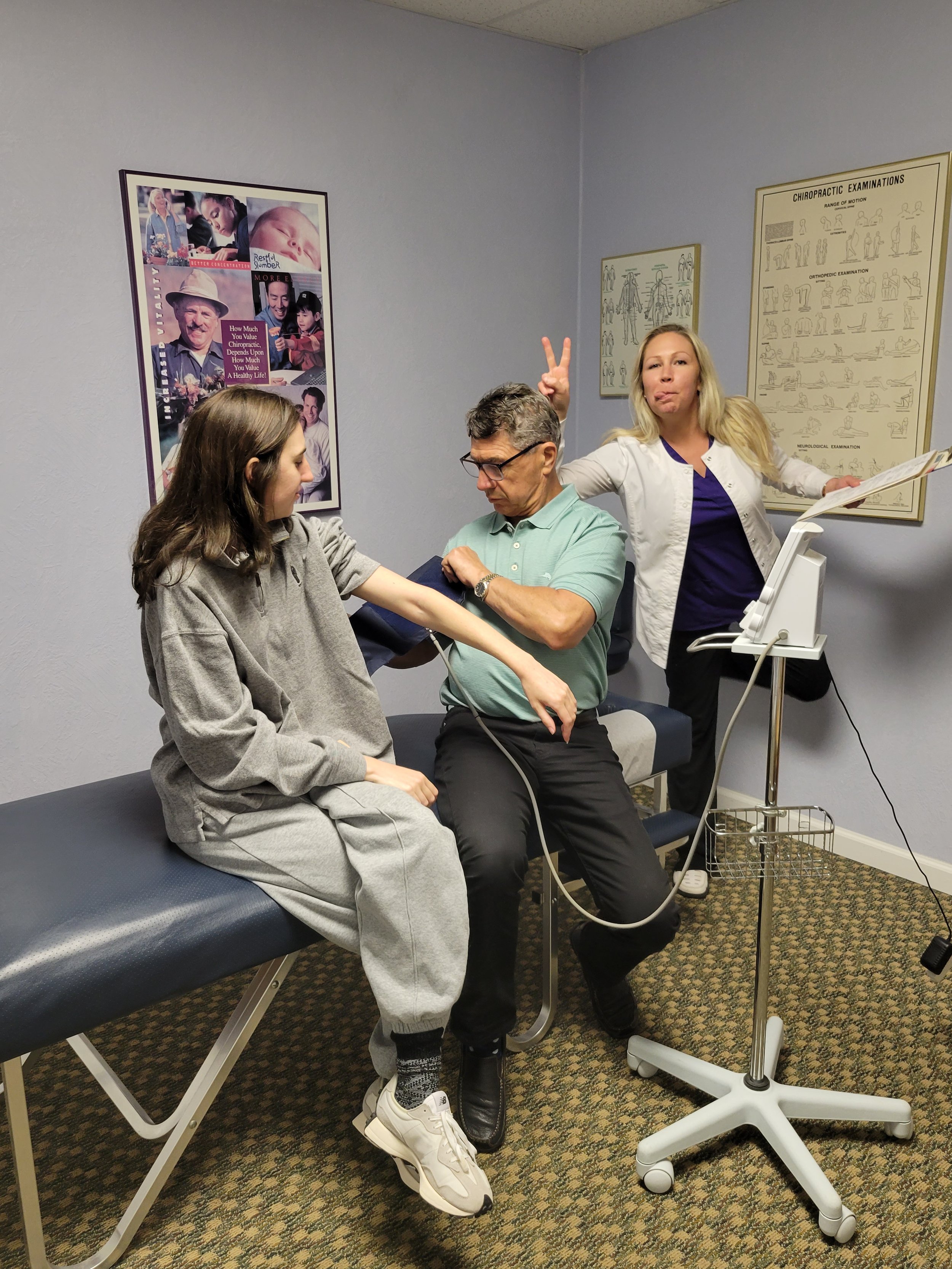
Chiropractic Care
What we offer
ChiroPractic Care
Gonstead Approach | The Gonstead chiropractic approach is known for its attention to detail, specificity, and a comprehensive evaluation process. It is focused on providing individualized care to address the unique needs of each patient. The Gonstead approach emphasizes a thorough evaluation and precise adjustment of the spine to restore proper alignment and function.
Activator Method | The Activator instrument allows chiropractors to apply a low-force adjustment to the identified subluxation. The device delivers a quick and controlled impulse, targeting the specific area of concern. The force can be adjusted based on the patient's comfort and needs.
Diversified Approach | Diversified chiropractors primarily use manual adjustment techniques to address subluxations and joint dysfunctions. These adjustments typically involve applying controlled and specific forces by hand to targeted areas of the spine or other joints. The goal is to restore normal joint motion, enhance spinal alignment, and optimize nervous system function.
Thompson Technique | The Thompson Technique is known for its gentle and comfortable adjustments. The chiropractor applies a specific force to the targeted joint, usually using a quick thrust with their hands or a small handheld instrument. The drop sections of the table help enhance the precision and effectiveness of the adjustment, while reducing the force required.
Arthrostim Method | It is a type of mechanical adjusting device that delivers rapid and controlled thrusts to specific areas of the spine or joints. The Arthrostim instrument utilizes a small rubber-tipped stylus that delivers multiple percussions per second, creating a gentle tapping or pulsating sensation. Chiropractors may use the Arthrostim to deliver targeted adjustments with precision, aiming to restore proper joint function, alleviate pain, and promote overall spinal health.
Electro muscle stem
We use EMS in combination with other treatments, such as manual therapies, exercises, or stretching, to create a comprehensive approach to patient care. The settings and parameters of EMS, including the intensity, frequency, and duration of the electrical currents, are adjusted based on the individual's condition, tolerance, and treatment goals.
UltraSound
Ultrasound therapy can help alleviate pain in injured or inflamed areas. The high-frequency sound waves produced by the ultrasound machine generate heat deep within the tissues. This heat increases blood flow, relaxes muscles, and promotes healing, leading to pain relief.
Physical Modalities
Physical modalities in chiropractic refer to therapeutic interventions and techniques that complement chiropractic adjustments. These modalities are aimed at providing pain relief, reducing inflammation, promoting healing, improving mobility, and enhancing overall well-being.
Traction
We use traction tables designed specifically for spinal decompression. These tables allow the patient to lie down comfortably while the table mechanically applies traction forces to the spine. Our traction tables have adjustable settings, allowing the chiropractor to customize the treatment based on the patient's condition.
Interferential Therapy
Interferential therapy is primarily used for pain relief. It can help reduce both acute and chronic pain associated with various musculoskeletal conditions. The electrical currents produced by the interferential therapy device interfere with pain signals, helping to block or reduce their transmission to the brain. This can result in temporary pain relief and improved comfort.
XrAys
X-rays in a chiropractic office are used primarily for diagnostic purposes, helping chiropractors gather critical information to develop an accurate diagnosis and create an effective treatment plan tailored to each patient's specific needs.
g-5
The G-5 massager is designed to provide deep tissue massage and vibratory stimulation to the muscles and soft tissues. Chiropractors may use the G-5 to target specific areas of tension or muscle tightness, applying the device directly to the skin or through a thin barrier like a towel or clothing.
How we can Help
-
A frequent and overlooked cause of headaches is the malfunction of spinal bones in the neck and upper back. When bones of the spine lose their normal position or motion, sensitive nerves and blood vessels to the head can be affected, producing a throbbing headache. Specific adjustments can help correct mechanical restrictions in the cervical spine that may be related to headache symptoms.
-
Sciatica, like other health problems that can be traced to the spine, often respond dramatically to the restoration of normal spinal function through conservative chiropractic care. Our approach uses carefully directed and controlled pressure to remove the interference from spinal structures. Adjustments can be quite effective in reducing nerve irritation and its associated pain.
-
A subluxation describes what happens when spinal bones lose their normal motion or position from stress, trauma or chemical imbalances. This can be caused by automobile collisions, improper lifting, drugs, alcohol, emotional stress, chemical imbalances, and long periods of sitting.
Chiropractic care focuses on detecting, reducing, and correcting subluxation.
-
Many patients with neck pain have lost the normal forward curve in the neck. This can affect the brain stem and spinal cord. With improved structure and function, neck pain often diminishes or totally disappears, without addictive drugs or harmful side effects.
-
Collision related injuries are often called a “whiplash.” The resulting instability of the spine and soft tissues can contribute to headaches, dizziness, blurred vision, pain in the shoulders, arms and hands, reduced ability to turn and bend, and low back problems. Symptoms may not appear until weeks or even months later.
After a thorough case history and examination, we will recommend a series of visits to help restore proper motion and position of spinal bones. If caught early enough, inflammation can be reduced and scar tissue can often be minimalized.
-
Since discs have a very poor blood supply, they also depend upon the circulation of joint fluids to bring in nutrients and expel waste. If a spinal joint loses its normal motion and this pumping action is impaired, the health of the disc deteriorates. Because they are attached to vertebrae, discs do not slip, but they do tear, bulge, herniate, prolapse and desiccate.
The chiropractic approach to disc problems is to help restore better motion and position to the spinal joints. Besides reducing disc bulging, better function helps decrease inflammation so the slow process of healing the surrounding soft tissues can begin.
-
Natural drug free way to get healthy
Ear infections
Menstrual problems
Digestive problems
Asthma
Bed-wetting
Lower and upper back pain
Shoulder pain
Arthritis
Restless leg sndrome
Insomnia
Carpal tunnel
Muscle spasms
Cramps and charley horses
Stress and anxiety
Pinched nerves
Tendinitis
-
One leg appears shorter than the other
Your heels wear out unevenly
Poor posture
You can’t take a satisfying deep breath
Your jaw “clicks”
You have headaches, back aches, sore or tender spots in muscles or joints
You have to “crack” your neck, back, or other joints a lot
You have constant stressful feeling and tension especially in muscles or joints
You can’t twist or turn your head or hips to either side easily or equally
You are often fatigued
You feel stiffness in your back and neck
You have poor concentration
You just don’t feel right
You have a low resistance to disease
Your foot flares out when walking
Fever, colic, croup
Constipation
Ear Infections
A foot turned out or in
Frequent colds
Muscular dystrophy
Eye Problems
Loss of hearing
Arthritis or Asthma
Scoliosis or curvature
What type of damage evolves from subluxation?
Muscle Damage
Muscles become tense
Spastic
Always tight
Muscles weaken
Cartilage, ligaments and tendons are weakened
Postural distortions
Nerve Damage
Nerves compressed, stretched, or pinched
Nerves function abnormally which can lead to pain, altered internal organ function and attention deficit disorders, addictive behaviors, psychosis and other conditions
Health Damage
Accelerated aging
Chronic fatigue
Lessened ability to respond to physical and emotional stress
Lowered resistance to disease
Joint degeneration, bone deformation, disc destruction
Loss of height
Can also affect
Immune system function
Organ health
Trophic substances
Emotional health
Joint Damage
Vertebrae out of proper alignment
Increased stress on joints, discs, and ligaments
“Locked” jammed joints
“Clicking” or too much movement in joints
Pain
Reduced range of motion
Loss of balance and posture
Shoulders, hips, knees, feet compensate for postural imbalance
Loss of energy, fatigue
Tissue Inflammation
Abnormal pressure on joints and nearby soft tissues
Swelling
Soft tissue Damage
Tender and painful to touch areas
“Hot” spots and trigger points
Unnatural wear and tear cause arthritic changes to the joints and nearby tissues
Identify action items
The Results
“Dr. Dolmat and his team are fantastic. Everyone is friendly and professional. Dr Dolmat really cares for his patients and does everything in his power to help. Not to mention his silly sense of humor!”
— Bobbi C.
Testimonials









